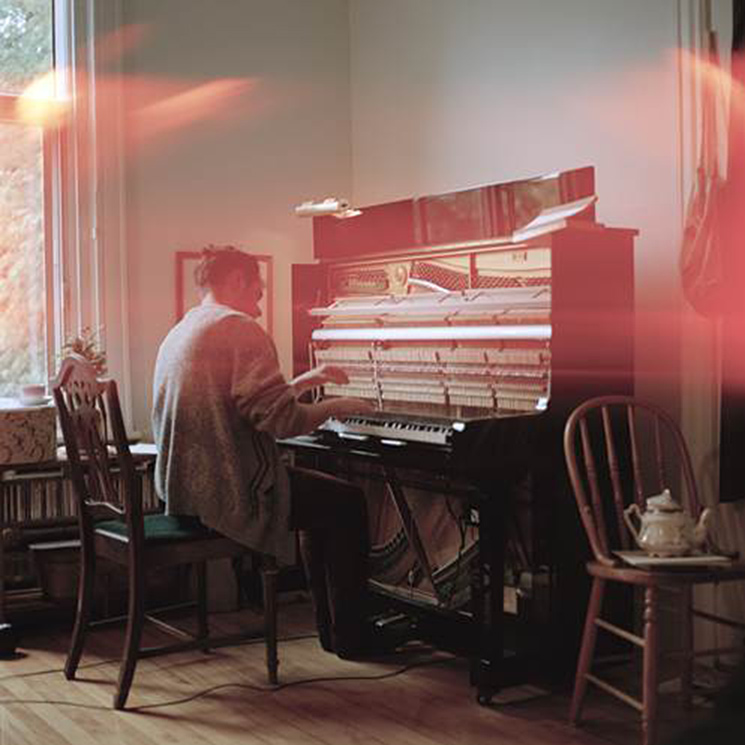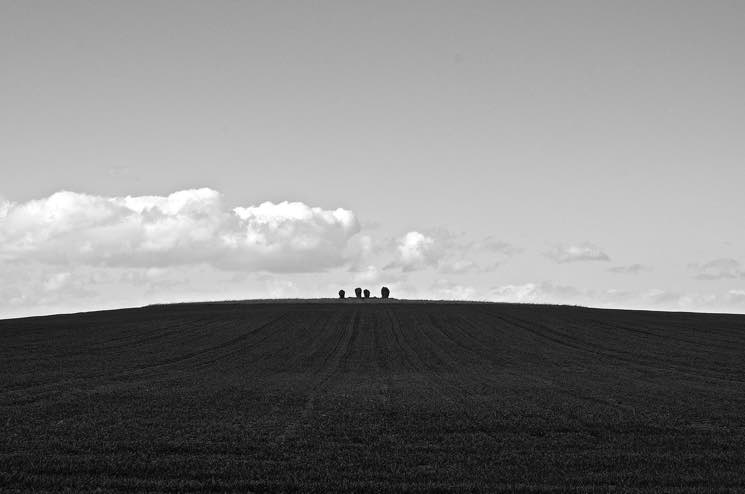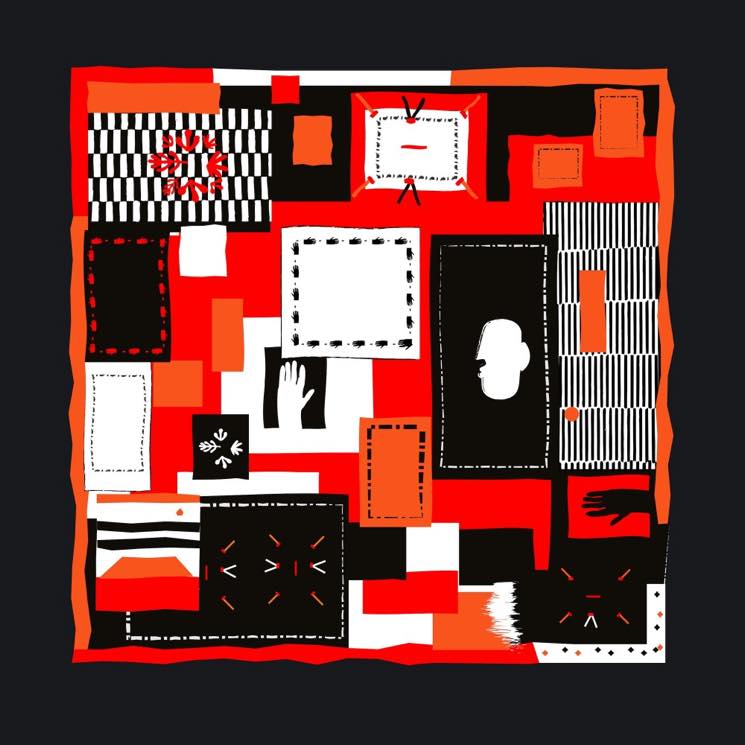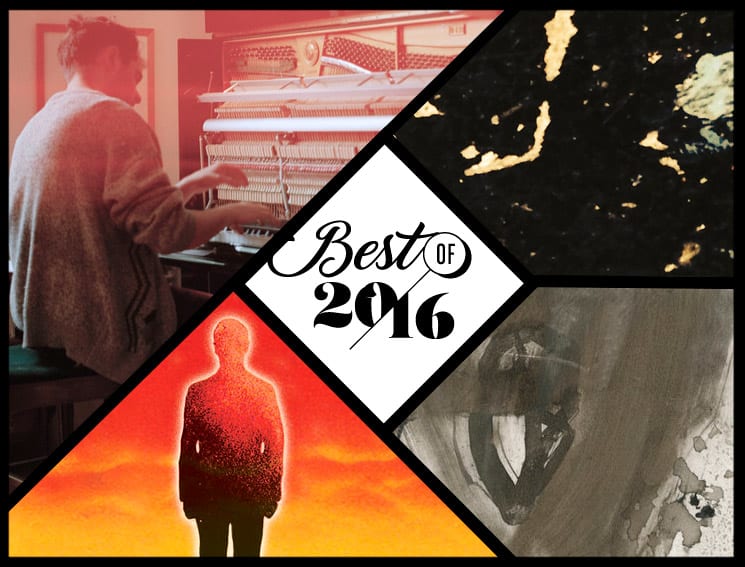Our Best of 2016 albums lists by genre end today with our staff picks for the 10 best improv and avant-garde albums released this year. Unlike on our other lists, these albums are not ranked; these are simply 10 of the best experimental albums released in 2016, arranged alphabetically.
Click next to read through the albums one by one, or use the list below to skip ahead to your favourites.
On Monday (December 12), our year-end coverage will continue with Exclaim!'s Top 10 EPs of 2016.
Top 10 Improv & Avant-Garde Albums of 2016:

Ben Lukas Boysen
Spells
(Erased Tapes)
If the staggering brilliance of Ben Lukas Boysen wasn't widely heard on the first studio album released under the Berlin-based composer, producer and sound designer's own name, 2013's Gravity, it sure was on Spells. Where his debut came out on the well-respected hardcore electronic imprint Ad Noiseam, Spells was Boysen's first album for Erased Tapes, and he seized the opportunity to work with arguably the world's leading contemporary classical music label by producing a neo-classical masterpiece.
The album's merging of sophisticated, meticulously programmed piano pieces with processed, live improvisations of drummer Achim Färber, cellist Anton Peisakhov and harpist Lara Somogyi (and all mixed and mastered by Nils Frahm) makes for a grandiose and atmospheric sound, deeply stirring and dramatic yet relaxing and delicate around the edges. Its compositions build on the ambient, minimal elegance of neo-classical greats like Jóhann Jóhannsson and Max Richter, and traverse the same foothills as the slowly swelling, profoundly haunting trips of doom-jazz giant the Kilimanjaro Darkjazz Ensemble. Spells is the sublime lull of being warm and dry on a cold and grey afternoon, the beauty of movement when one is compelled to sit still. Simply put, Spells is spellbinding.
Alan Ranta

Charles Barabé
Les Dernières Confessions
(Orange Milk)
Charles Barabé has spent the better part of this decade doing two amazing things: curating the intimate yet immense Victoriaville-based La Cohu imprint, and splattering the loveliest of synthesizer-based sound bombs across numerous reams of magnetic tape. That he's offered up these sonic curios for the world to gorge themselves on is a blessing for those who've listened. Les Dernières Confessions is not the only tape that Barabé has released this year, and it's not his longest, either (the double cassette Cicatrices takes that particular prize).
It is, however, his best. That this debut was made for the always amazing/outrageous Orange Milk Records label — which counts sonic deviants such as Foodman, Giant Claw, Man Made Hill and Piper Spray as alumni — designates it something of a match made in synthetic heaven, and the output of Les Dernières Confessions is exemplary of this predestined union. Coming across as a series of near-symphonic masterpieces, the music is emotionally charged, engaging and full of energy. It's Barabé at his best — and that's pretty darn epic.
Bryon Hayes

Daniel Lanois
Goodbye to Language
(Anti-)
In a sense, Daniel Lanois's subtle stamp makes an uncredited appearance on most modern music. His early explorations of tone and atmosphere in record production, as a collaborator with Brian Eno and on his own, have guided musicians and producers in their attempts to infuse songs with a sense of mysterious place.
This year brought us stellar guitar-based instrumental records, including Modern Country by William Tyler and Into the Light by Marisa Anderson, and each owe something (an audience even) to Lanois's efforts to further such sounds. His own Goodbye to Language features intermingling pedal and lap steel guitars and almost nothing else. Country and western instruments keeping up with technology and a modern world, Lanois manipulates their haunting eruptions and creates these stirring, off-kilter, rubbery soundscapes.
Eyes closed, headphones on, Goodbye to Language is truly transporting — a document filled with echoes of the past and reverberating whirring from the always uncertain future.
Vish Khanna

Ian William Craig
Centres
(130701)
You can just hear Ian William Craig's mom now: "Honey, you have such a beautiful voice, why are you trying to bury it under all that noise?" But the true appeal of Centres, the third LP from the Edmonton experimentalist, lies not just within his beautiful voice or even all that noise — it's all about the specific type of texture Craig chooses to construct.
Yes, it's true that the 36-year-old uses faulty and decrepit tape machines to create his end-days recordings (which is nothing new; see William Basinski) alongside electronic-tinged classical arrangements (see also Hauschka), but there's something about Craig's utter dedication to modifying and fucking with every note and every element that makes this 13-track LP so absorbing. Ian William Craig's tactile obsession with sound gives Centres' sweeping moments an eerie feel, its stoic moments an urgent feel. Every vocal comes off like an angelic drone, while every drone sounds like nothing less than the absolute logical choice.
Daniel Sylvester

Jean-Michel Blais
Il
(Arts & Crafts)
After becoming discouraged by the rigid nature of his conservatory studies at age 17, Canadian pianist Jean-Michel Blais began asking bigger questions about classical piano and what music could be. His belief that the style should be viewed as a living thing, as opposed to sounds of centuries past, is reflected on his debut record, Il. Blais's playing is at once immersive and intricate, able to appeal to both genre purists and casual listeners. As he told Exclaim! earlier this year, striking such a balance is, to him, playing "both cards at the same time."
Blais's recording method was also instrumental in moving his music beyond the genre's rigidity he once found so stifling. Sounds of his own breathing, children speaking, birds singing and mechanical noises from a friend's camera were all captured by the handheld audio recorder within his apartment studio, giving life to Il and Blais's musings on music.
Calum Slingerland

Kaitlyn Aurelia Smith
Ears
(Western Vinyl)
With EARS, Kaitlyn Aurelia Smith has produced a mesmerizing and beautiful album that pulses with life in a way few other electronic records (or any record, for that matter) managed to.
In fact, the most compelling attribute of EARS is the way it sounds like something discovered in nature, perhaps at the bottom of a teeming puddle. The impressionistic gurgles of the Buchla synthesizer, the distant timbres of voice and woodwind and the autonomy Smith gives to her electronics all contribute to a sense that EARS was not so much written as it was grown and cultivated.
Enlisting a woodwind player (Rob Frye) to lay down most of the record's melodic content was one of Smith's smartest moves. The breath present in the flutes and saxophones preserves the music's organic textures, blending harmoniously with Smith's vocals and tempering the album's other non-human elements.
EARS is the product of Smith's multifarious talents, including expert control of Buchla synthesizers, a sharp ear for dense sound design and a knack for simple but effective compositions. Most importantly, though, EARS is the product of a vibrant imagination — one that we'll hopefully hear more from soon.
Will Pearson

Paul Newman
Duo Compositions
(Independent)
Let's face it: Things are getting intense. And intensity has a tendency to wear you down. So in 2016, where can one find a patch of consideration and craft that simply expresses doggedly intelligent conversation?
The answer is on Duo Compositions, the latest from Toronto musician and composer Paul Newman. His compositions on this release are brought to full realization in duet with Karen Ng on tenor saxophone and Heather Saumer on trombone. Newman joins on tenor saxophone.
Each track here is measured and thoughtful, taking its time getting to the point. The listener is asked neither to brace themselves or prepare for a tiring commitment; rather, they're presented with music that has both the confident framing of baroque and the modern erudition of jazz lineage.
Duo Compositions is at once easily received and, yet, does not insult the listener's intelligence with arcane simplicity. Make no mistake: This is graceful, sophisticated music — and beautiful, at that.
Nilan Perera

Sarah Neufeld
The Ridge
(Paper Bag)
Sarah Neufeld already occupied a unique space in the music world by wielding her virtuosic violin skills both in the pop context of Arcade Fire and as a soloist. But after recording her debut, 2013's Hero Brother, in far-off destinations with experimental minimalist Nils Frahm, she's added a texture to her sophomore album not often associated with classical-leaning music: youthful jubilance.
Neufeld herself has said that the record felt "really connected to the idea of youth energy… this crackling, sparkling, on-the-edge-of-something energy," and it's audible throughout The Ridge, from the bright, twisting "We've Got a Lot" to the kinetic flurry of "From Our Animal." For the first time, Neufeld introduces her airy mezzo-soprano to the mix here, adding humanity and life to her already vivacious compositions, but as usual, it's her ingenious approach to playing her instrument that really fascinates.
The Ridge is the sound of a master stretching out and finding that challenging, mind-expanding music can be joyful, too.
Stephen Carlick

Sarathy Korwar
Day to Day
(Ninja Tune)
How often do you get to hear an album that combines post-bop jazz, avant-garde electronics and sacred Indian folk music — and does so with grace and skill?
For his debut album, Sarathy Korwar travelled back to India to work with and record Sidi musicians (Sufi Muslims of African heritage). The chanting and hand percussion from these sessions formed the bedrock for this album, and then Korwar invited some jazz musicians into the studio to interact with and modify the material further. Korwar plays kit drums, tabla and electronics, and a good chunk of the melodic work is also done by Shabaka Hutchings's bass clarinet and tenor sax.
If you want to pick out one specific technical detail to highlight the virtuosic musicianship here, it could be the way in which the sections with increased tempos creep up on your attention because of how they're informed by melodic content (and not merely a repeated loop getting faster).
Day to Day effortlessly conveys a very human sense of hope. It's truly inspirational.
Peter Ellman

Skeletons
Am I Home?
(Shinkoyo/Altin Village and Mine)
As inapplicable as the concept of "proper" is to Matt Mehlan's continually evolving experimental anything-fusion ensemble Skeletons, Am I Home? is the proper full-length studio follow-up to 2011's utterly sublime People. Calling it King Crimson-on-Afrobeat with a side of Broadcast barely scratches the surface of Skeletons' unique, bombastic explorations, but that description still works as an apt primer for the group's vast array of heavily spliced influences and masterful musicianship on Home?
For all their wild excursions into freeform jazz and abstract synth texture building, Skeletons are as focused on songs as complete stories here, both musically and lyrically; even moments that are jarring in their unexpected juxtaposition don't create any sense of disconnect, just dramatic tension.
From the fluttering machine gun drum rolls and insistent driving bass of "It's Infinite"; through the spacey afro-funk of "The City"; the vibrant, groovy progressive celestial folk jazz of "Success"; the swirling controlled chaos of frantic percussion, sweeping synths, throbbing bass and tight spine of repetitive interlocked guitar and marimba of "Isn't Infinite"; all the way past the belligerent squalling horns that introduce album closing comedown strums of "Another Week"; Matt Mehlan guides and shapes the confounding gale-force creativity of his intrepid band into sonic experiences of rare, strange beauty.
Am I Home? is the most consistently realized work yet by a woefully underheard group of fearless artists creating music thoroughly infused with their distinct personality.
Scott Gray
Click next to read through the albums one by one, or use the list below to skip ahead to your favourites.
On Monday (December 12), our year-end coverage will continue with Exclaim!'s Top 10 EPs of 2016.
Top 10 Improv & Avant-Garde Albums of 2016:
- Ben Lukas Boysen - Spells
- Charles Barabé – Les Dernières Confessions
- Daniel Lanois - Goodbye to Language
- Ian William Craig - Centres
- Jean-Michel Blais - Il
- Kaitlyn Aurelia Smith - Ears
- Paul Newman - Duo Compositions
- Sarah Neufeld - The Ridge
- Sarathy Korwar - Day to Day
- Skeletons - Am I Home?

Ben Lukas Boysen
Spells
(Erased Tapes)
If the staggering brilliance of Ben Lukas Boysen wasn't widely heard on the first studio album released under the Berlin-based composer, producer and sound designer's own name, 2013's Gravity, it sure was on Spells. Where his debut came out on the well-respected hardcore electronic imprint Ad Noiseam, Spells was Boysen's first album for Erased Tapes, and he seized the opportunity to work with arguably the world's leading contemporary classical music label by producing a neo-classical masterpiece.
The album's merging of sophisticated, meticulously programmed piano pieces with processed, live improvisations of drummer Achim Färber, cellist Anton Peisakhov and harpist Lara Somogyi (and all mixed and mastered by Nils Frahm) makes for a grandiose and atmospheric sound, deeply stirring and dramatic yet relaxing and delicate around the edges. Its compositions build on the ambient, minimal elegance of neo-classical greats like Jóhann Jóhannsson and Max Richter, and traverse the same foothills as the slowly swelling, profoundly haunting trips of doom-jazz giant the Kilimanjaro Darkjazz Ensemble. Spells is the sublime lull of being warm and dry on a cold and grey afternoon, the beauty of movement when one is compelled to sit still. Simply put, Spells is spellbinding.
Alan Ranta

Charles Barabé
Les Dernières Confessions
(Orange Milk)
Charles Barabé has spent the better part of this decade doing two amazing things: curating the intimate yet immense Victoriaville-based La Cohu imprint, and splattering the loveliest of synthesizer-based sound bombs across numerous reams of magnetic tape. That he's offered up these sonic curios for the world to gorge themselves on is a blessing for those who've listened. Les Dernières Confessions is not the only tape that Barabé has released this year, and it's not his longest, either (the double cassette Cicatrices takes that particular prize).
It is, however, his best. That this debut was made for the always amazing/outrageous Orange Milk Records label — which counts sonic deviants such as Foodman, Giant Claw, Man Made Hill and Piper Spray as alumni — designates it something of a match made in synthetic heaven, and the output of Les Dernières Confessions is exemplary of this predestined union. Coming across as a series of near-symphonic masterpieces, the music is emotionally charged, engaging and full of energy. It's Barabé at his best — and that's pretty darn epic.
Bryon Hayes

Daniel Lanois
Goodbye to Language
(Anti-)
In a sense, Daniel Lanois's subtle stamp makes an uncredited appearance on most modern music. His early explorations of tone and atmosphere in record production, as a collaborator with Brian Eno and on his own, have guided musicians and producers in their attempts to infuse songs with a sense of mysterious place.
This year brought us stellar guitar-based instrumental records, including Modern Country by William Tyler and Into the Light by Marisa Anderson, and each owe something (an audience even) to Lanois's efforts to further such sounds. His own Goodbye to Language features intermingling pedal and lap steel guitars and almost nothing else. Country and western instruments keeping up with technology and a modern world, Lanois manipulates their haunting eruptions and creates these stirring, off-kilter, rubbery soundscapes.
Eyes closed, headphones on, Goodbye to Language is truly transporting — a document filled with echoes of the past and reverberating whirring from the always uncertain future.
Vish Khanna

Ian William Craig
Centres
(130701)
You can just hear Ian William Craig's mom now: "Honey, you have such a beautiful voice, why are you trying to bury it under all that noise?" But the true appeal of Centres, the third LP from the Edmonton experimentalist, lies not just within his beautiful voice or even all that noise — it's all about the specific type of texture Craig chooses to construct.
Yes, it's true that the 36-year-old uses faulty and decrepit tape machines to create his end-days recordings (which is nothing new; see William Basinski) alongside electronic-tinged classical arrangements (see also Hauschka), but there's something about Craig's utter dedication to modifying and fucking with every note and every element that makes this 13-track LP so absorbing. Ian William Craig's tactile obsession with sound gives Centres' sweeping moments an eerie feel, its stoic moments an urgent feel. Every vocal comes off like an angelic drone, while every drone sounds like nothing less than the absolute logical choice.
Daniel Sylvester

Jean-Michel Blais
Il
(Arts & Crafts)
After becoming discouraged by the rigid nature of his conservatory studies at age 17, Canadian pianist Jean-Michel Blais began asking bigger questions about classical piano and what music could be. His belief that the style should be viewed as a living thing, as opposed to sounds of centuries past, is reflected on his debut record, Il. Blais's playing is at once immersive and intricate, able to appeal to both genre purists and casual listeners. As he told Exclaim! earlier this year, striking such a balance is, to him, playing "both cards at the same time."
Blais's recording method was also instrumental in moving his music beyond the genre's rigidity he once found so stifling. Sounds of his own breathing, children speaking, birds singing and mechanical noises from a friend's camera were all captured by the handheld audio recorder within his apartment studio, giving life to Il and Blais's musings on music.
Calum Slingerland

Kaitlyn Aurelia Smith
Ears
(Western Vinyl)
With EARS, Kaitlyn Aurelia Smith has produced a mesmerizing and beautiful album that pulses with life in a way few other electronic records (or any record, for that matter) managed to.
In fact, the most compelling attribute of EARS is the way it sounds like something discovered in nature, perhaps at the bottom of a teeming puddle. The impressionistic gurgles of the Buchla synthesizer, the distant timbres of voice and woodwind and the autonomy Smith gives to her electronics all contribute to a sense that EARS was not so much written as it was grown and cultivated.
Enlisting a woodwind player (Rob Frye) to lay down most of the record's melodic content was one of Smith's smartest moves. The breath present in the flutes and saxophones preserves the music's organic textures, blending harmoniously with Smith's vocals and tempering the album's other non-human elements.
EARS is the product of Smith's multifarious talents, including expert control of Buchla synthesizers, a sharp ear for dense sound design and a knack for simple but effective compositions. Most importantly, though, EARS is the product of a vibrant imagination — one that we'll hopefully hear more from soon.
Will Pearson

Paul Newman
Duo Compositions
(Independent)
Let's face it: Things are getting intense. And intensity has a tendency to wear you down. So in 2016, where can one find a patch of consideration and craft that simply expresses doggedly intelligent conversation?
The answer is on Duo Compositions, the latest from Toronto musician and composer Paul Newman. His compositions on this release are brought to full realization in duet with Karen Ng on tenor saxophone and Heather Saumer on trombone. Newman joins on tenor saxophone.
Each track here is measured and thoughtful, taking its time getting to the point. The listener is asked neither to brace themselves or prepare for a tiring commitment; rather, they're presented with music that has both the confident framing of baroque and the modern erudition of jazz lineage.
Duo Compositions is at once easily received and, yet, does not insult the listener's intelligence with arcane simplicity. Make no mistake: This is graceful, sophisticated music — and beautiful, at that.
Nilan Perera

Sarah Neufeld
The Ridge
(Paper Bag)
Sarah Neufeld already occupied a unique space in the music world by wielding her virtuosic violin skills both in the pop context of Arcade Fire and as a soloist. But after recording her debut, 2013's Hero Brother, in far-off destinations with experimental minimalist Nils Frahm, she's added a texture to her sophomore album not often associated with classical-leaning music: youthful jubilance.
Neufeld herself has said that the record felt "really connected to the idea of youth energy… this crackling, sparkling, on-the-edge-of-something energy," and it's audible throughout The Ridge, from the bright, twisting "We've Got a Lot" to the kinetic flurry of "From Our Animal." For the first time, Neufeld introduces her airy mezzo-soprano to the mix here, adding humanity and life to her already vivacious compositions, but as usual, it's her ingenious approach to playing her instrument that really fascinates.
The Ridge is the sound of a master stretching out and finding that challenging, mind-expanding music can be joyful, too.
Stephen Carlick

Sarathy Korwar
Day to Day
(Ninja Tune)
How often do you get to hear an album that combines post-bop jazz, avant-garde electronics and sacred Indian folk music — and does so with grace and skill?
For his debut album, Sarathy Korwar travelled back to India to work with and record Sidi musicians (Sufi Muslims of African heritage). The chanting and hand percussion from these sessions formed the bedrock for this album, and then Korwar invited some jazz musicians into the studio to interact with and modify the material further. Korwar plays kit drums, tabla and electronics, and a good chunk of the melodic work is also done by Shabaka Hutchings's bass clarinet and tenor sax.
If you want to pick out one specific technical detail to highlight the virtuosic musicianship here, it could be the way in which the sections with increased tempos creep up on your attention because of how they're informed by melodic content (and not merely a repeated loop getting faster).
Day to Day effortlessly conveys a very human sense of hope. It's truly inspirational.
Peter Ellman

Skeletons
Am I Home?
(Shinkoyo/Altin Village and Mine)
As inapplicable as the concept of "proper" is to Matt Mehlan's continually evolving experimental anything-fusion ensemble Skeletons, Am I Home? is the proper full-length studio follow-up to 2011's utterly sublime People. Calling it King Crimson-on-Afrobeat with a side of Broadcast barely scratches the surface of Skeletons' unique, bombastic explorations, but that description still works as an apt primer for the group's vast array of heavily spliced influences and masterful musicianship on Home?
For all their wild excursions into freeform jazz and abstract synth texture building, Skeletons are as focused on songs as complete stories here, both musically and lyrically; even moments that are jarring in their unexpected juxtaposition don't create any sense of disconnect, just dramatic tension.
From the fluttering machine gun drum rolls and insistent driving bass of "It's Infinite"; through the spacey afro-funk of "The City"; the vibrant, groovy progressive celestial folk jazz of "Success"; the swirling controlled chaos of frantic percussion, sweeping synths, throbbing bass and tight spine of repetitive interlocked guitar and marimba of "Isn't Infinite"; all the way past the belligerent squalling horns that introduce album closing comedown strums of "Another Week"; Matt Mehlan guides and shapes the confounding gale-force creativity of his intrepid band into sonic experiences of rare, strange beauty.
Am I Home? is the most consistently realized work yet by a woefully underheard group of fearless artists creating music thoroughly infused with their distinct personality.
Scott Gray
